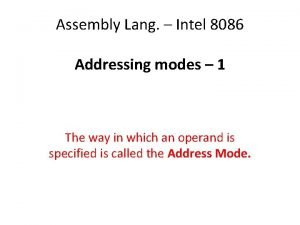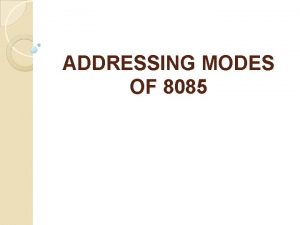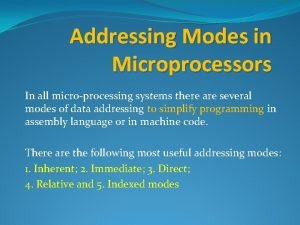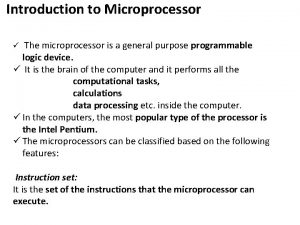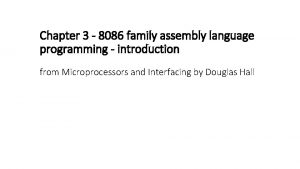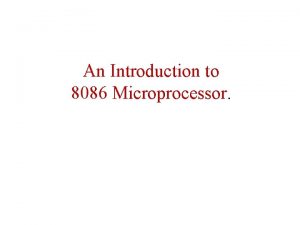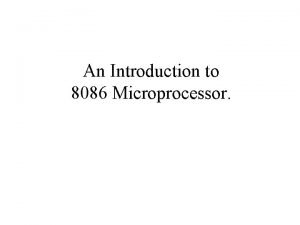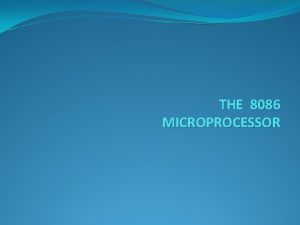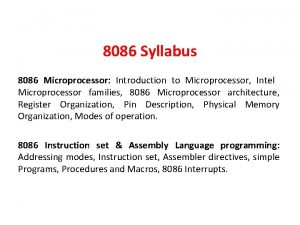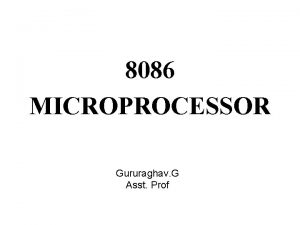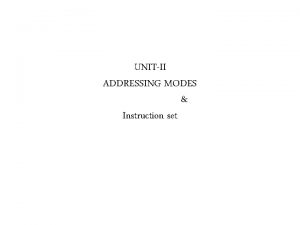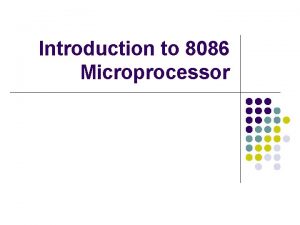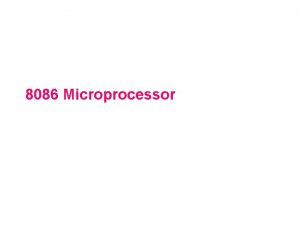8086 ADDRESSING MODES 8086 Microprocessor Introduction Program A









- Slides: 9

8086 ADDRESSING MODES

8086 Microprocessor Introduction Program A set of instructions written to solve a problem. Instruction Directions which a µP follows to execute a task or part of a task. Computer language High Level Machine Language �Binary bits Low Level Assembly Language ¾ English Alphabets ¾ ‘Mnemonics’ ¾ Assembler Mnemonics Machine Language 2

8086 Microprocessor Addressing Modes Every instruction of a program has to operate on a data. The different ways in which a source operand is denoted in an instruction are known as addressing modes. 1. Register Addressing 2. Immediate Addressing Group I : Addressing modes for register and immediate data 3. Direct Addressing 4. Register Indirect Addressing 5. Based Addressing 6. Indexed Addressing Group II : Addressing modes for MM data 7. Based Index Addressing 8. String Addressing 9. Direct I/O port Addressing 10. Indirect I/O port Addressing Group III : Addressing modes for I/O ports 11. Relative Addressing Group IV : Relative Addressing mode 12. Implied Addressing 4 Group V : Implied Addressing mode

8086 Microprocessor Addressing Modes 1. Register Addressing Group I : Addressing modes for register and immediate data 2. Immediate Addressing The instruction will specify the name of the register which holds the data to be operated by the instruction. 3. Direct Addressing Example: 4. Register Indirect Addressing 5. Based Addressing MOV CL, DH 6. Indexed Addressing The content of 8 -bit register DH is moved to another 8 -bit register CL 7. Based Index Addressing (CL) (DH) 8. String Addressing 9. Direct I/O port Addressing 10. Indirect I/O port Addressing 11. Relative Addressing 12. Implied Addressing 5

8086 Microprocessor Addressing Modes Group I : Addressing modes for register and immediate data 1. Register Addressing 2. Immediate Addressing 3. Direct Addressing 4. Register Indirect Addressing 5. Based Addressing In immediate addressing mode, an 8 -bit or 16 -bit data is specified as part of the instruction Example: MOV DL, 08 H 6. Indexed Addressing The 8 -bit data (08 H) given in the instruction is moved to DL 7. Based Index Addressing (DL) 08 H 8. String Addressing 9. Direct I/O port Addressing 10. Indirect I/O port Addressing 11. Relative Addressing MOV AX, 0 A 9 FH The 16 -bit data (0 A 9 FH) given in the instruction is moved to AX register (AX) 0 A 9 FH 12. Implied Addressing 6

8086 Microprocessor Addressing Modes : Memory Access 20 Address lines 8086 can address up to 220 = 1 M bytes of memory However, the largest register is only 16 bits Physical Address: PA will have to be calculated Physical Address : Actual address of a byte in MM, i. e. the value which goes out onto the address bus. MM Address represented in the form Segment : Offset (Eg - 89 AB: F 012) AKA LOGICAL ADDRESS: LA Each time µP wants to access memory, it takes contents of a segment register, shifts it one hexadecimal place to the left then add the required offset to form the 20 - bit address 89 AB : F 012 89 AB 0 F 012 0 F 012 + ------98 AC 2 Offset Adrs Absolute address or PA 8

8086 Microprocessor Direct Addressing Group II : Addressing modes for memory data 1. Register Addressing 2. Immediate Addressing 3. Direct Addressing 4. Register Indirect Addressing Here, effective address of MM location at which data operand is stored is given in the instruction. 5. Based Addressing Effective address is just a 16 -bit number written directly in the instruction. 6. Indexed Addressing Example: 7. Based Index Addressing MOV 8. String Addressing 9. Direct I/O port Addressing 10. Indirect I/O port Addressing 11. Relative Addressing 12. Implied Addressing BX, [1354 H] BL, [0400 H] Square brackets around the 1354 H denotes the contents of MM location. When executed, this instruction will copy contents of MM location into BX register. This addressing mode is called direct because the displacement of operand from the segment base is specified directly in the instruction. 10

8086 Microprocessor Addressing Modes Group II : Addressing modes for memory data 2. Immediate Addressing In Register indirect addressing, name of register which holds effective address (EA) will be specified in the instruction. 3. Direct Addressing Registers used to hold EA are any of the following: 4. Register Indirect Addressing BX, BP, DI and SI. 5. Based Addressing Content of DS register is used for base address calculation. 1. Register Addressing 6. Indexed Addressing 7. Based Index Addressing Example: 8. String Addressing MOV CX, [BX] 9. Direct I/O port Addressing 10. Indirect I/O port Addressing 11. Relative Addressing 12. Implied Addressing Note : Register/ MM enclosed in brackets refer to content of register/ MM Operations: EA = (BX) BA = (DS) x 1610 PA = BA + EA (CX) (PA) or, (CL) (PA) (CH) (PA +1) 11

8086 Microprocessor 1. Register Addressing 2. Immediate Addressing 3. Direct Addressing 4. Register Indirect Addressing 5. Based Addressing 6. Indexed Addressing 7. Based Index Addressing 8. String Addressing 9. Direct I/O port Addressing 10. Indirect I/O port Addressing 11. Relative Addressing 12. Implied Addressing Group II : Addressing modes for memory data Addressing Modes In Based Addressing, BX or BP is used to hold the base value for effective address and a signed 8 -bit or unsigned 16 -bit displacement will be specified in the instruction. In case of 8 -bit displacement, it is sign extended to 16 -bit before adding to the base value. When BX holds the base value of EA, 20 -bit physical address is calculated from BX and DS. When BP holds the base value of EA, BP and SS is used. Example: MOV AX, [BX + 08 H] Operations: 0008 H (Sign extended) EA = (BX) + 0008 H BA = (DS) x 1610 PA = BA + EA (AX) (PA) or, (AL) (PA) (AH) (PA + 1) 12
 Addressing modes of 8086 microprocessor
Addressing modes of 8086 microprocessor Indexed addressing mode in 8086
Indexed addressing mode in 8086 Addressing modes of 8086 microprocessor with examples
Addressing modes of 8086 microprocessor with examples Addressing modes in 8085
Addressing modes in 8085 Addressing modes definition
Addressing modes definition Introduction to microprocessor
Introduction to microprocessor Flat addressing vs hierarchical addressing
Flat addressing vs hierarchical addressing Assembly language program development tools
Assembly language program development tools Introduction of 8086 microprocessor
Introduction of 8086 microprocessor Introduction to 8086 microprocessor
Introduction to 8086 microprocessor


